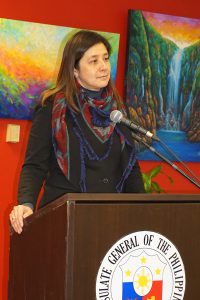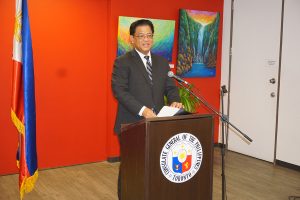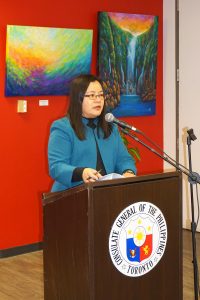The fear and what you need to know
The fear and what you need to know

Dr. Eileen de Villa, Medical Officer of Health for the City of Toronto (Photo: MC Ramos)
COVID-19 Briefing at Toronto Philippine Consulate
By Michelle Chermaine Ramos
The Philippine Reporter
With the worldwide anxiety over the novel coronavirus (COVID-19) after the World Health Organization declared a global health emergency on January 30, 2020, news and misinformation have been spreading online with discussions even delving into conspiracy theories.
The main questions most Canadians have are about how high the risk levels are in our community and what steps we can take to protect ourselves and our loved ones.
It is time to pit the facts against the fear. On February 13, 2020, the Philippine Consulate General in Toronto held an information session with Toronto’s Medical Officer of Health, Dr. Eileen de Villa who shared the latest updates and her advice. According to Dr. de Villa, at this time, the risk represented by this new coronavirus to the health of our community here in Toronto is low as there have only been two confirmed cases as of Feb. 13, 2020 which her team at Toronto Public Health is continuously monitoring as the individuals recover.
Anxiety in a high-tech world of misinformation
After handling SARS 17 years ago, Dr. de Villa noted that while there are similarities between the situation then and now with COVID-19, the science has significantly advanced since then in the way that doctors were able to identify the virus in a few short weeks after COVID-19 emerged in late 2019. This was not possible as recently as ten years ago. Technology have improved and the exchange of information in the scientific community is much faster now compared to the SARS era. However, with the advancement of technology, we also have the presence of significantly more social media platforms today that did not exist in 2003. People are encouraged to seek their information from credible sources such as the Toronto Public Health website which Dr. de Villa says they are updating as the information come in.

Consul General Orontes V. Castro (Photo: MC Ramos)New virus
New virus
Much of the fear surrounding the novel coronavirus (COVID-19) is the fact that it is new and doctors still have lots to learn about how it works, transmits and how it can be cured. After being discovered in late 2019 when many had contracted a pneumonia-like illness, the virus was only identified recently on January 12, 2020. Doctors around the world are scrambling to develop a vaccine and Dr. de Villa reported that several efforts to develop antiviral medications are underway including an experimental drug Remdesivir by Gilead Sciences and initial work done for SARS and MERS which is a reasonable place to start. However, the technology for vaccine development is still notoriously slow. “Most of the experts in vaccine development are saying that a new vaccine to manage novel coronavirus is at least a year away and I think that’s with super-fast collaboration,” says Dr. de Villa.
How does Toronto Public Health monitor cases?
They monitor the individuals’ symptoms daily through phone calls while they remain in isolation recovering at home to make sure that their conditions are actually improving. “They do not get released from isolation and are only able to return to their regular activities when we get two tests taken at least 24 hours apart showing that they have no more virus present in their bodies,” explains Dr. De Villa. This is how all other potential cases of COVID-19 in Ontario are to be handled. Her team manages infectious diseases every day with roughly 50,000 cases of such diseases in the city of Toronto in any given year. They are still studying the novel coronavirus simply because it is still new, but she assures the public that they are extremely experienced in dealing with infectious diseases. They also do contact follow-up by finding out who might have been exposed to an ill person so that they can inform them to take the same precautions and assist them in seeking treatment should they need to in order to prevent the spread of the disease.

Consul Edna May Lazaro (Photo: MC Ramos)
Travel bans and temperature screening
As for travel bans and temperature screening, the federal government of Canada has opted not to do any of that. According to scientific literature, travel bans have been generally found to perhaps delay the spread of disease, but not stop it. “That’s the current state of the scientific evidence so I think that’s why we’re taking this approach. Again, not a decision that’s within my ability to make but just knowing what my federal counterparts look at, I’m sure that weighed heavily within their considerations,” Dr. De Villa explains. They are taking action on the best available evidence and for now, the risk of getting COVID-19 in Toronto is very low. The evidence for the need for temperature screening at the airport is poor and it is more accurate to use a regular clinical thermometer to monitor a patient’s daily temperature to determine their condition. As new information continues to flow in, they will be modifying their approach by following the best available evidence so we should expect to see changes as things evolve as their understanding of the virus changes with more data.
WHAT YOU NEED TO KNOW:
The Numbers – Bad and relatively good news
Expect the numbers to constantly change. The death toll has already risen to over 2,000 worldwide and the number of confirmed cases has hit over 75,000 as of the time of this writing (Feb. 19). And yes, the number will go up. However, the small consolation here is the fact that the true fatality rate is not as high as the reported number. In order to calculate what percentage of infected patients actually die, they count the deaths over the number of patients to determine the fatality rate. The fact is they do not know exactly how many people actually have the disease because the only ones the doctors are aware of are those who are sick enough to bother to get a lab test and CT scan. Also, just like other coronaviruses, the novel coronavirus will cause some illness that is so mild in some people that they are not seeking medical care. They may be asymptomatic or just mildly symptomatic on top of the fact that is it also respiratory virus season in China just like it is here. People may think they have one of the other standard viruses so they simply stay home until they get better and carry on with their lives. Therefore, doctors do not yet have a full picture of exactly how many have the disease, so the total number of cases is definitely underestimated. “By definition we know that whatever figure that we’re reporting on case fatality right now is too high. We just don’t know what the real number is yet. And over time the hope is we’ll start to figure out what that really looks like,” says Dr. de Villa.

Group photo of Dr. Eileen de Villa and Consul General Orontes Castro with community leaders and consular staff.
(Photo: MC Ramos)
What should travelers from China do?
Since the majority of cases still in China continue to be in Hubei province, the Public Health Agency of Canada advises those who have come or are coming to Canada who have travelled to Hubei province within 14 days to limit their contact with people by self-isolating for a period of 14 days after the last time they were in Hubei. They are also to report to their local public health authority within 24 hours of arriving in Canada so that they will be able to get the proper treatment should they develop signs and symptoms within the next 14-day period of self-isolation.
If you have travelled to mainland China outside of Hubei for the last 14 days, monitor yourself for signs and symptoms of fever, cough and difficulty breathing for a 14-day period. Should those symptoms arise, call your local public health department and seek medical care in a way that actually informs healthcare providers of what your symptoms are and especially of your travel history, so that the appropriate containment measures can be provided to care for you while also protecting the rest of the community.
What can you do to protect yourself?
The advice from infectious disease specialists and the entire spectrum of medical professionals is to wash your hands thoroughly and frequently with soap and water. If you do not have access to a sink, use an alcohol-based hand sanitizer and as soon as you get the opportunity later, wash your hands with soap and water. This is one of the best things you can do to protect yourself from a spectrum of respiratory viruses including COVID-19 to the other regular coronaviruses that cause colds, influenza and other respiratory diseases. Avoid touching your face because it is easy for the virus to gain entry points into your system through your eyes, nose and mouth. Another reason it is imperative to keep your hands clean as often as you can is so in case you do touch your face, hopefully it will be free of the virus.
If you have to cough or sneeze, do so into a tissue or cover it up with your elbow or your sleeve and then wash your hands with soap and water or use an alcohol-based hand sanitizer. Try to avoid people who are coughing or sneezing and stay at least six feet or two meters away. Dr. de Villa also encourages people to get their flu shot every year near the beginning of cold and flu season which runs from November to around March. While the flu shot will not protect you from the novel coronavirus, it will protect you from influenza which causes 12,000 hospitalizations in Canada every year and unfortunately leads to some untimely deaths. Stay at home if you are sick in order to prevent spreading the illness to others.
Eat well and get a good amount of sleep every night. Try to get regular physical exercise. This does not require anything fancy or going to the gym. Going out for a walk is good for your health.
Should you wear a mask?
It is not necessary for a member of the general public to wear a mask. The best evidence for the need for masks for personal protection is for health care workers who are actually taking care of sick patients and who are trained on how to use them properly. Like other protective equipment, masks should be put on and taken off correctly with washed hands before and after use. Originally designed for health professionals, they are meant to be worn for only a short period of time for the duration of the medical procedures and not all afternoon. Dr. de Villa explained that mask wearing has become something some members of the public do to make themselves feel better but might actually be doing some harm especially if not worn properly to cover both the nose and mouth, if they end up touching parts of the mask they are not supposed to touch or if they simply neglect to wash their hands because they feel they are already protected by simply wearing one. However, if you are sick with a respiratory illness and need to go out in public to visit the doctor or the pharmacy or anywhere, there is some evidence that wearing a mask will limit the possibility of you spreading your disease to others. Wear it for a limited period of time to do your errands and then stay at home until you are well.
Is it safe to go out to restaurants and movie theatres?
At this time, the risk in our community is still low, though that may change. Another thing to remember is our understanding of how respiratory viruses are transmitted. While we still do not have a full understanding of this novel coronavirus in particular because it is new, what we do know is like many other respiratory viruses, it is generally spread by respiratory droplets when people cough and sneeze. These travel two meters or six feet before dropping to the ground. For now, it is still safe to attend social gatherings which are actually good for your health. Just make sure you take good precautions by washing your hands often and keeping your distance from someone who is coughing or sneezing and carry on with life as normal.
How to protect your pets
SARS in 2003 came from the civet cat while MERS-CoV in 2012 came from camels. Both are different types of coronaviruses that made the jump from animals to humans. “These coronaviruses have pieces of genetic material and they tend to borrow different pieces of genetic material from different viruses. So when you have animals in close proximity to humans and those animals have coronaviruses and those humans have coronaviruses, sometimes those viruses exchange genetic material and then you have a virus that might have only been in an animal before now spreading to humans,” Dr. de Villa explains. So, what can you do to protect your pets? Continue to play with your pets but always wash your hands before and after touching them.
What about goods or mail from China?
Dr. de Villa said that they do not know everything yet as full studies have not yet been done. However, that is not the major route of transmission for respiratory viruses. The main means of infection is by exposure to an infected person’s respiratory secretions and secondly, through your hands. However, viruses do not survive on surfaces for particularly long. “Goods from China, I don’t expect that to be a major route if at all. You do not need to worry about mail or products – not from a coronavirus reason,” she says.
In a nutshell:
Carry on with life as normal but expect to hear changes. It is human nature to be anxious about new risks and uncertainty. However, the best way to manage that is to stay informed. As we hear about the rising number of “cases” and “contacts” and cold-sounding clinical terms all over the world, Dr. De Villa also stressed the importance of not losing sight of the human element of this global issue. “One of the things that I’ve been trying to bring up and bring forward in my conversations with the public is while those are terms that we use in the world of public health, I think it’s very important to remember that at the end of the day we are talking about people.” When the news first broke about the two COVID-19 patients in Toronto, there was flurry of media people flocking around the hospital to get information. Dr. de Villa stressed the importance of patients needing space and privacy to recover. We also have to avoid giving in to fear which has led to incidents of anti-Asian racism. “It’s very important that we remember that those are not just numbers. Those are people at the end of the day,” Dr. de Villa emphasized. “That’s somebody’s mother, father, sister, brother, child, neighbor, coworker or friend. Let’s not lose sight of the human element. That’s actually the most important part of this whole thing.”
For more information, call the Toronto Public Health Hotline at 416 338 7600
Monday-Friday 8:30 a.m. – 8:00 p.m. Saturday and Sunday 10:00 a.m. – 6:00 p.m.
Translation is available in many languages. Please share with your colleagues, networks and other communities.
Comments (0)